Orchid: caring for it, reproduction, features and varieties of a flower
Orchids can be found all over the world. They grow on trees, rocks, ground, and there are some that live on rotting stumps. The most frost-resistant calypso orchid reaches the forest tundra. It is difficult to find a general description of orchids due to the myriad variety of species.
Content:
- Orchid history
- General description of the orchid
- Features of orchid care
- Orchid transplant
- Reproduction of orchids
- Orchid varieties
Orchid history
These beautiful flowers, surrounded by legends, have been known since ancient times. The first orchids existed 130 million years ago. In China and Japan, the orchid was famous for its medicinal properties. The first to draw attention to orchids and the Chinese started breeding them. On ancient Chinese vases, you can often see the image of this flower.
Confucius mentioned him more than once in his works, calling him "the king of fragrant flowers."
In the 18th and 19th centuries, orchid fever swept through England. Expeditions were sent to various exotic countries in the hope of bringing this unearthly flower and learning how to breed it in the weather conditions of Foggy Albion. Not everyone was lucky.
The epidemic of orchid craze in Europe begins in the 1830s, when a dried flower was sent to an English botanist from the Bahamas. He thought that life might still remain in him, and just in case he put it in a pot. To the surprise of everyone, the flower came to life and a year later bloomed with amazing pink flowers.
Orchid is a symbol of love and new life.
She is called "the aristocrat among the plants." The history of this flower is shrouded in many legends. So, there is a legend that beautiful flowers appeared from fragments of a rainbow. According to another legend, the orchid grew in the place where the goddess Aphrodite dropped her shoe.
General description of the orchid
Experienced flower growers know how capricious an orchid is; caring for it requires special knowledge. But with proper maintenance and care, it will delight you with a long flowering.
For all the time of its existence, the orchid has about 30 thousand species. Flowers have a wide variety of shades and shapes, resemble lizards, swans, butterflies. Among the species diversity, the ofri orchid is the most original:
- It seems that bees and wasps are constantly sitting on its flowers, not flying away even at night.
- The flowers themselves have adapted perfectly, imitating the abundance of insects. This is how they attract pollinators.
The unearthly beauty of the Japanese orchid Habenaria radiata is legendary.
It is also called the White Heron Orchid because of its birdlike flowers. When a long ago young shepherd grazed his goats in the meadow. He was saddened that he would never be a warrior, a samurai because of his low birth. Reflecting on the injustice of life, he looked up to the sky and saw beautiful white birds. The herons distracted him from his sad thoughts. When the shepherd lowered his eyes, he saw a white flower very much like herons. He dug the plant and planted it in a pot at home. This flower always reminded him of a simple truth told by the Buddha: "Everything in the world that comes is like the flight of birds. Only beauty remains eternal."
Features of orchid care
Orchid is a rather demanding flower.The conditions of its maintenance should be as close as possible to those in which it grew in the natural environment. Therefore, care directly depends on the type of orchid and the geographical characteristics of its growth.
Orchids perceive heat differently.
On this basis, they can be divided into 3 groups:
- Heat-loving group. These include orchids, which grow primarily in rainforests. They need warm conditions. The optimum temperature for keeping is from 15 to 32 degrees during the day and 15-18 degrees at night.
- Medium temperature group. These plants like cooler conditions. Daytime temperatures should not exceed 22 degrees, and winter night temperatures should not exceed 15 degrees.
- Cold-loving group. These orchids grow either in the highlands or in the subtropics. The optimal summer daytime temperature for them is 22 degrees, winter night temperatures from 12 to 15 degrees.
Beyond temperature lighting plays an important role... Orchids love light, but not direct sunlight. The light should be diffused. When the sun is too bright, the plant needs to be protected with plastic or matte sheeting. In autumn and winter, there is not enough sunlight, so you can resort to artificial lighting.
Watering the plant:
- The frequency and intensity of watering depends on the type of orchid.
- Flowers respond best to soft water: boiled or rainwater.
- Do not use cold or hot water for irrigation.
- The optimum water temperature is 2-3 degrees higher than the indoor air temperature.
Fertilizer for orchids easy to find in any flower shop. Top dressing is carried out during the growth period once every three weeks.
The orchid blooms at the age of 1.5-2.5 years. Flowering is influenced by many factors:
- The length of daylight hours affects the formation of flower buds.
- The difference between night and day temperatures should have a difference of 5-7 degrees. Lowering the temperature to +16 degrees will help speed up flowering.
- Watering. Reducing watering stimulates kidney formation.
- Most often, garden soil is not added to the soil for orchids. It includes bark, coal, moss, clay, cork, sand, and other constituents.
- For an orchid, it's best to use a simple plastic pot with holes to drain the water.
The recommended air humidity required for favorable growing of orchids is 60-80%. It is not necessary to use humidifiers, a tray with grates will be enough, where you can pour water. It is important that the bottom of the pot does not touch the water.
Orchid transplant
Many people seek to transplant an orchid immediately after purchase. But transplanting a flower without any apparent reason for this is highly undesirable. There are a number of signs indicating that it's time to transplant the flower.
The wilted appearance of the plant is a clear sign of the unhealthy orchid and a signal with a transplant:
- If the substrate in the pot is a donkey and there is a free space, then it's time to transplant the flower and change the substrate.
- If the orchid gives off an unpleasant odor of mold, dampness, or you notice there are traces of decay on the leaves, then the plant needs a transplant.
- It is worth paying attention to the roots. Healthy roots are green. If they have darkened, acquired a brown tint, or there are signs of decay on them, the flower must be urgently transplanted.
- Container damage is also a reason for transplant.
To transplant an orchid, use a looser pot than the old one.
Lift the flower out of the pot carefully. The roots must be cleaned of the substrate, rinsed with water. Pour the substrate into the prepared container (pot) at the bottom, place a flower in it and fill it with new soil, slightly compact. The top of the orchid should be visible. The soil should be slightly damp. At first, the transplanted orchid should be in the shade.
Reproduction of orchids
If you have made enough friends with the orchid, you can start propagating these plants. Spring is best for orchid propagation.There are three ways to reproduce a flower: vegetative propagation (with the help of parts of the mother plant), generative (seed propagation) and meristem propagation or cloning.
There are several rules to follow for any reproduction:
- Instruments must be prepared and disinfected before use.
- The roots must be handled very carefully. The damage can be fatal.
- It is advisable to moisten the substrate before planting with boiled water.
- Place the plant in a warm, dark place for several weeks.
- At first, it is better not to water the flower, but only spray it once a day.
Vegetative propagation involves various methods. Reproduction using stem offspring is possible if the air temperature in the room where the orchid is kept is high enough. In this case, small new plants appear, which can then be separated and planted, but after they have taken root themselves.
Some types of indoor orchids can be propagated by layering in a nearby pot.
For this, a long leafless stem is used. He is taken to a pot with sphang moss. To speed up the process, the leafless shoot is kept in a greenhouse for some time and regularly moistened.
Orchid varieties
The Orchid family includes 796 genera and about 25 thousand species, deciduous and evergreengrowing in various conditions around the globe.
Consider a few common orchid genera.
- Phalaenopsis. The petals of this exquisite flower closely resemble the wings of a butterfly. Translated from Greek, phalania means "moth". This genus of orchids is very popular. He is handsome and relatively unpretentious to care for. The flowers are quite large. The color can be very different - from light to bright pink. It blooms several times a year.
- Dracula. A gloomy but beautiful flower. Outwardly, this type of orchid resembles a dragon's mouth. Your favorite flower is ready, especially in dark shades. It has become a symbol of Gothic beauty. This flower can be pollinated not only by insects, but also by bats or shrews.
- Paphiopedilum. This plant is named so because of its resemblance to a shoe (paphia - Venus, pedilon - sandal). The species differ in the color of the leaves: in some they have a solid green color, in others they have an inhomogeneous color with dark patterns. Flowers are usually arranged one by one per plant. Paphiopedilum blooms for a very long time, about 2 months.
- Cattleya. There are 2 types of this orchid, differing in morphological characteristics. The first type is elongated fleshy bulbs of predominantly pink, purple and white colors. The second type is long cylindrical pseudobulbs, flowers of a denser structure and different shades.
- Dendrobium. Literally the name translates as "tree-dwelling". The shape and color of the flowers is varied and depends on the species. A common feature of all species of this genus is the base of the lip curled around the column.
- Aganizia. The Greek word "acacallis" is translated as "nymph". Inflorescences usually have 3-5 large flowers. This plant loves light, moisture, air. It grows well on a breathable substrate.
- Wanda. Indoor orchids of this type reach a height of 80 cm. The inflorescence consists of several flat flowers, usually fragrant and bright. The most common colors are white, pink, blue, purple. It usually blooms in spring and summer with sufficient light and humidity.
More information can be found in the video.




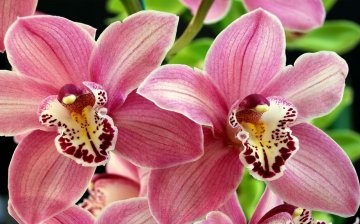

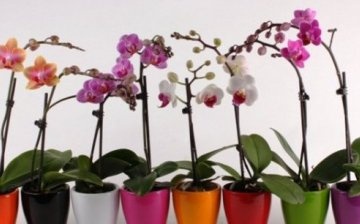










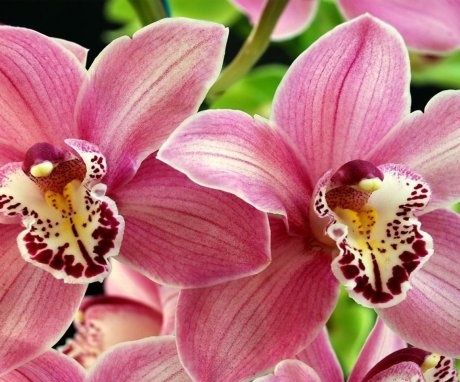
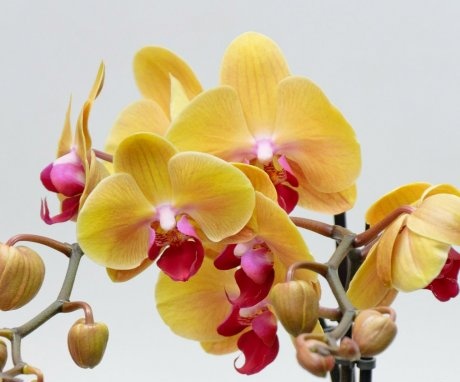
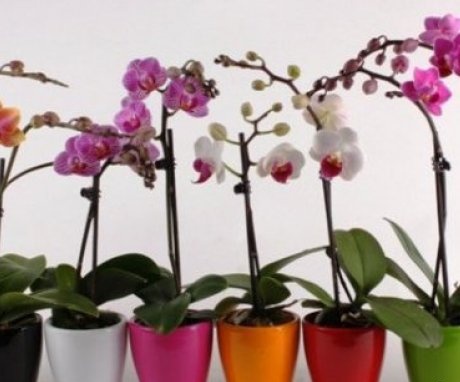
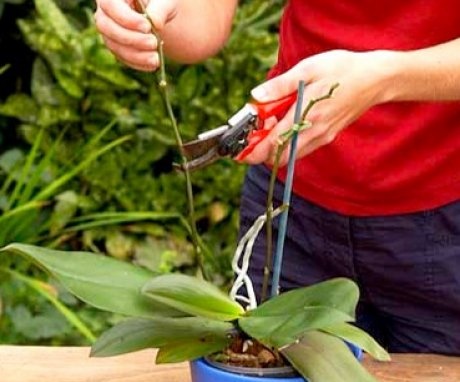

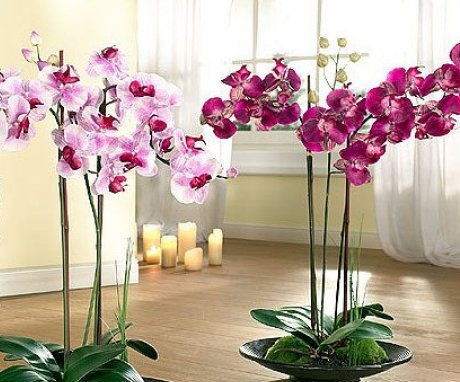
We have a phalaenopsis orchid, it has many beautiful white flowers that delight us for more than a month. How many times we tried to propagate the plant, nothing came of it. We read, watched videos, all in vain. We water the flower sparingly and sparingly, we don't hide the orchid from the sun.